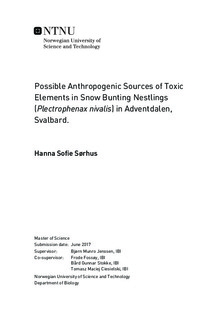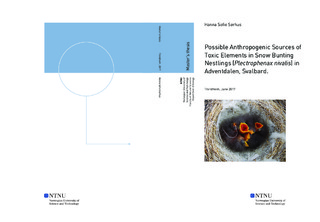| dc.description.abstract | The Arctic environment is exposed to natural and anthropogenic contamination as a result of local, regional and global pollution. Contaminants accumulating in the Arctic may influence both biotic and abiotic factors. Previous research has quantified elevated concentrations of toxic elements in a confined area between Endalen and Todalen in Adventdalen, Svalbard. The overall aim of the present study was to determine the sources of contamination in this particular area by systematically examining element concentrations in soil, insects, spiders, and feathers of snow bunting nestlings (Plectrophenax nivalis). Assumptions regarding elevated concentrations of toxic elements focuses on coal industry related elements (As, B, Be, Cd, Co, Fe, Mn, Mo, Ni, Pb, S, Sm, Th, U, Y, Yb), and elements related to operations at a wartime weather station (Bansø) (Al, Ba, Ce, Cr, Hg, La, Li, Rb, Sb, Se, Tl, V, Zn, Zr).
The study area was divided into a grid pattern consisting of 25 cells. Soil, insect, spider, and nestling feather samples from each cell were collected in June and July 2016, and element composition was quantified using HR-ICP-MS. The principal component analysis (PCA) indicates that most contamination in the investigated area is related to local sources, probably of anthropogenic origin. The results show that cells located close to a coal mine adit (Mine 5) and coal piles have elevated concentrations of coal related elements in soil and feathers, but not in invertebrates. The cell located closest to the coal mine adit is not statistically significant (p>0.05). This indicates that coal contamination not necessarily affects the toxic element concentrations in invertebrates.
The soil samples from cell D3 (p<0.001), where the Bansø weather station is located, do not show elevated concentrations. Cell D3 show high concentrations in invertebrates, which indicates the importance of this station. Because of lacking data for feathers in the Bansø cell, no conclusion can be drawn regarding the station s impact on birds. However, there are quantified elevated concentrations of Bansø related elements in feathers in Bansø s adjacent cells, which indicate an impact also for birds. The present thesis have not examined parental foraging strategies in snow buntings, and can thus not exclude other possible sources for elevated concentrations, neither for coal related nor Bansø related elements. Based on the results, it can be assumed that the remains of Bansø weather station affects local biota more than coal contamination do. In addition, the results indicate presence of biomagnification of toxic elements, and further studies are therefore recommended. | |

